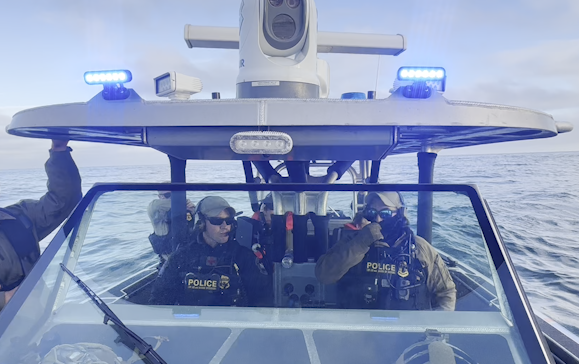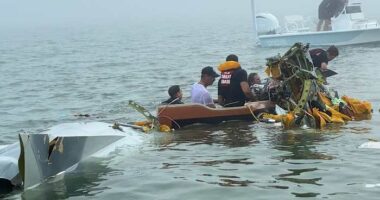Share this @internewscast.com
SAN DIEGO (Border Report) — By the time the sun rose over the San Diego skyline Wednesday morning, agents with Customs and Border Protection’s Air and Marine Operations unit had already been on the water patrolling the California coastline for hours.
Their fast-moving boats cost $1 million a piece and are designed to intercept all sorts of smuggling events on the water.
“That encompasses pangas, small vessels, jet skis, swimmers, all of those are considered marine events,” said Eric LaVergne, spokesman with U.S. Border Patrol.
Border Report was one of several media outlets invited to observe how CBP agents and officers patrol the water looking for vessels that might be carrying migrants.
“They’re on 24/7,” LaVergne said.
While land encounters along the southern land border have hit historic lows, interdictions on the water have remained steady and consistent with previous years.
“Since October 1, the start of the 2025 fiscal year, there have been just under 400 smuggling events,” LaVergne said.


Most of the incursions into the U.S. on the water take place on panga boats, wooden fishing vessels with an outboard motor in the back.
According to LaVergne, most are not made for long hauls over the unpredictable Pacific Ocean.
“You’re looking vessels that anywhere else would not be considered seaworthy, but are used for smuggling events, so when you’re putting 20 to 25 people aboard that vessel and you break down, there’s no one to call out there,” he said. “You’re on your own unless you are rescued by the Coast Guard, Navy or someone else.”

He also mentioned they expect more smuggling events on the water as legal pathways into the U.S. have diminished and illegally crossing the land border has become increasingly difficult.
According to migrant advocates, migrants are being charged anywhere from $10,000 to $15,000 each to cross the border on a boat.
CBP has also noticed smugglers are becoming more bold.
“Smugglers are becoming more brazen in their activities, we’ve seen individuals landing boats in the middle of the day nearly hitting surfers and swimmers in the waves they’re beaching their vessels.”

So far this fiscal year, which began Oct. 1, seven migrants have died while illegally crossing into the U.S. in the water.
Three drowned in May, including a 14-year-old boy from India and his 10-year-old sister when the boat they were in capsized in the surf near Del Mar, California.
“The only way for us to handle the maritime problem is by working with a whole government approach between Air and Marine operations, United States Coast Guard, United States Border Patrol, they’re out here every day.”
Even with several federal agencies patrolling the waters off the California coast, LaVergne says it’s hard curtailing and stopping all the illegal maritime crossings.
“When you think of it, overall you have a 20-foot vessel in the Pacific Ocean that is a large area, it’s not a needle in a haystack, it’s a little needle in the needle stack, when you’re looking out at that kind of area.”
And when they do encounter a smuggling event in progress, LaVergne says smugglers always tend do their best to evade arrest.
“Smugglers, they don’t want to give up they have no reason of giving up, they will run,” he said. “They will beach the vessel, they will do what they can to escape prosecution.”













